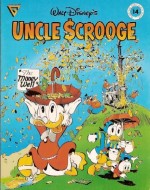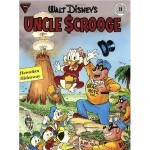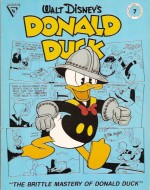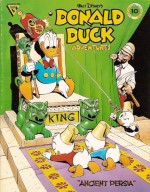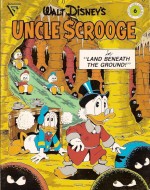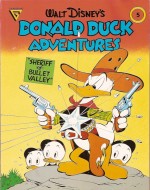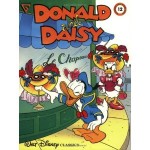
By Carl Barks and others (Gladstone Comic Album #12)
ISBN: 978-0-944599-112
Carl Barks was born in Merrill, Oregon in 1901, reared in the rural areas of the West during some of the leanest times in American history. He tried many jobs before settling into the profession that chose him: storytelling with a pen and brush. After a succession of professions Barks drifted into cartooning and joined the Disney studio as an animator before quitting in 1942 to work in the newborn field of comicbooks.
His life-path gelled when, with cartoon studio partner Jack Hannah (himself an occasional strip illustrator) Barks adapted a Bob Karp script for an sidelined animated short feature into the comicbook Donald Duck Finds Pirate Gold (published as Dell Four Color Comics Series II #9 in October of that year). Although not his first published comics work, it was the story that dictated the rest of his career.
From then until his official retirement in the mid-1960s Barks worked in self-imposed isolation seclusion, writing and drawing a vast array of adventure comedies, gags, yarns and covers, creating a Duck Universe of memorable and highly bankable characters such as Gladstone Gander, Gyro Gearloose, Magica De Spell, the Beagle Boys and his greatest creation – the crusty, energetic, paternalistic, money-mad Quinquillionaire Scrooge McDuck to supplement Disney’s stable of cartoon actors.
Whilst producing all that landmark material Barks was just a working guy, generating cover art, illustrating other people’s scripts when asked and contributing stories to the burgeoning canon of Duck Lore. Although equally revered for his astonishingly impressive adventure sagas, slapstick romps and punchy page-gags he was just another cog in a big machine and diligently toiled on whatever his editors asked him to.
A solid example of how well he worked on characters he wasn’t invested in and scripts he hadn’t concocted is this Gladstone album co-starring Donald Duck’s occasional paramour Daisy…
So potent were Barks’ creations that they inevitably fed back into Disney’s animation output itself, even though his comic work was done for the licensing company Dell/Gold Key, and not directly for the studio. The greatest tribute was undoubtedly the animated series Duck Tales, heavily based on his comics output of the 1950s and 1960s wherein Daisy and her nieces The Little Chickadees, freed from the social constraints of the 1950s and 1960s, finally came into their independent own…
During this period “ladies†were not brash or forceful or potent – whether by Disney dictat, Dell editorial policy or simply in deference to the tone of the times is unclear – unless they were fallen or wicked, such as Bark’s own darker dames like Glittering Goldie (see Walt Disney’s Uncle Scrooge: Back to the Klondike) or sinister sorceress Magica De Spell, and as such were relegated to sternly disapproving partners or maternal role models. Even under these conditions however, Barks occasionally managed to inject a little spark into the distaff ducks…
Gladstone Publishing began re-packaging Barks material and a selection of other Disney comics strips in the 1980s and this intriguing tome is among the best – as they all seem to be. As always this album is printed in the large European oversized format (278mm x 223mm) – although dedicated collectors should also seek out the publisher’s superb line of Disney Digests and comics books that grew out of these pioneering tomes for more of the most madcap, wryly funny yarns ever concocted.
As discussed in Geoffrey Blum’s introduction Barks considered Daisy a “diluting influence†and often had to rewrite her parts, if not actually kill stories in which she played a stronger woman, but even on these terms the five short yarns here, one scripted by an anonymous writer but most by the master himself, are a striking example of triumph under adversity…
Daisy is little more than a bit-player in the untitled first tale (Walt Disney’s Comics and Stories #101, February 1949) in which Donald and nephews Huey, Dewey and Louie take a series of extreme measures to cure nightmares, whilst in the second ‘The Daisy Hunt’ she becomes an unwilling prize in a romantic duel for her affections between Donald and aggravatingly lucky rival Gladstone Gander (first seen in untitled Walt Disney’s Comics and Stories #117, June 1950).
She plays a far more forceful but still ferociously domestic role in the untitled housecleaning yarn from Walt Disney’s Comics and Stories #213, June 1958 wherein she mercilessly hunts Donald down after he breaks a promise to help her spring clean the house.
As the 1960s advanced and women became less fragile flowers and more potent partners Daisy had a short run of her own title under the umbrella of the Four Colour Comics tryout title. From #1055 (November 1959) of Daisy Duck’s Diary comes ‘The TV Babysitter’ (illustrated but not written by Barks) in which she ultimately fails to keep control of the nephews even with the help of Gyro Gearloose’s latest surveillance technology, whilst in ‘Donald and Daisy: The Beauty Business’ (Walt Disney’s Comics and Stories #308, May 1966) her feminine insecurity almost ruins Donald’s latest career as a glamour beautician…
Even though not up to his usual uniquely high standards, it’s fascinating to see what Barks could do with stories that didn’t engage him 100% – and this collection is magnificent proof of his overwhelming creative and work ethic – as these stories all still contain the dry wit, artistic verve and sly satirical punch that made Carl Barks supreme among his very talented contemporaries and the most important anthropomorphic storyteller since Kenneth Grahame and Rudyard Kipling.
No matter what your age or temperament if you’ve never experienced this captivating magic of Barks, you can discover “the Hans Christian Andersen of Comics†simply by applying yourself and your credit cards to any search engine. So why don’t you…?
© 1988, 1966, 1959, 1958, 1950, 1949 The Walt Disney Company. All rights reserved.

